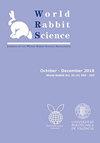家兔(Oryctolagus cuniculus)在麻醉或不麻醉下交配射精和电射精时发出的声音特征
IF 1.3
4区 农林科学
Q3 AGRICULTURE, DAIRY & ANIMAL SCIENCE
引用次数: 0
摘要
发声可以被用作疼痛的可靠指标,但在兔子身上几乎没有可用的信息,因为在那里,用于农业环境的声学工具可以用于福利判断。本研究的目的是比较在有或没有全身麻醉的情况下,家兔在交配射精和电射精(EE)过程中产生的发声。九名新西兰成年白人男性的声音被数字记录下来。分析了男性发声的数量和发声特征,包括高、低、最大和基频以及发声的持续时间。交配时第一次和第二次射精的雄性发声次数或任何发声参数都没有差异,尽管第二次性交时所有雄性的基频都增加了(P=0.008)。交配时发声的雄性比电射精时多(P=0.03),EE期间的所有发声参数都比交配时大(P=0.004)。EE期间是否使用麻醉并没有改变任何评估的参数。结果表明:1)交配射精时发声的雄性多于电射精时;2) 生物声学分析使我们能够识别厌恶性发声,其特征是频率高于非厌恶性刺激;和3)至少在麻醉组合和所研究的反应的情况下,麻醉对兔子在EE期间发出的发声的声学特性没有影响。本文章由计算机程序翻译,如有差异,请以英文原文为准。
Acoustic characteristics of vocalisations emitted by the domestic rabbit (Oryctolagus cuniculus) during copula ejaculation and electro-ejaculation with or without anaesthesia
Vocalisations can be used as reliable indicators of pain, but little information is available in rabbits, where acoustic tools for farming environments can be used for welfare judgements. The aim of this study was to compare vocalisations produced during copula ejaculation and electro-ejaculation (EE), with or without general anaesthesia, in domestic rabbits. Vocalisations of nine New Zealand white adult males were digitally recorded. The number of males vocalising and vocal characteristics including high, low, maximum and fundamental frequencies and duration of the vocalisations were analysed. There were no differences in the number of males vocalising or any vocalisation parameter between the 1st and 2nd ejaculation while copulating, even though the fundamental frequency increased in all males in the 2nd ejaculation (P=0.008). More males vocalised while mating than while being electro-ejaculated (P=0.03), and all vocalisation parameters were greater during EE than while mating (P=0.004). The use or not of anaesthesia during EE did not modify any of the parameters evaluated. It was concluded that: 1) more males vocalised during copula ejaculation than while being electro-ejaculated; 2) bio-acoustic analysis allowed us to identify aversive utterance vocalisations, which are characterised with higher frequencies, that those from non-aversive stimulus; and 3) at least with the anaesthetic combination and the responses studied, anaesthesia had no effect on the acoustic characteristics of the vocalisation emitted during EE in rabbits.
求助全文
通过发布文献求助,成功后即可免费获取论文全文。
去求助
来源期刊

World Rabbit Science
农林科学-奶制品与动物科学
CiteScore
1.70
自引率
25.00%
发文量
22
审稿时长
>36 weeks
期刊介绍:
World Rabbit Science is the official journal of the World Rabbit Science Association (WRSA). One of the main objectives of the WRSA is to encourage communication and collaboration among individuals and organisations associated with rabbit production and rabbit science in general. Subject areas include breeding, genetics, production, management, environment, health, nutrition, physiology, reproduction, behaviour, welfare, immunology, molecular biology, metabolism, processing and products.
World Rabbit Science is the only international peer-reviewed journal included in the ISI Thomson list dedicated to publish original research in the field of rabbit science. Papers or reviews of the literature submitted to World Rabbit Science must not have been published previously in an international refereed scientific journal. Previous presentations at a scientific meeting, field day reports or similar documents can be published in World Rabbit Science, but they will be also subjected to the peer-review process.
World Rabbit Science will publish papers of international relevance including original research articles, descriptions of novel techniques, contemporaryreviews and meta-analyses. Short communications will only accepted in special cases where, in the Editor''s judgement, the contents are exceptionally exciting, novel or timely. Proceedings of rabbit scientific meetings and conference reports will be considered for special issues.
World Rabbit Science is published in English four times a year in a single volume. Authors may publish in World Rabbit Science regardless of the membership in the World Rabbit Science Association, even if joining the WRSA is encouraged. Views expressed in papers published in World Rabbit Science represent the opinion of the author(s) and do not necessarily reflect the official policy of the WRSA or the Editor-in-Chief.
 求助内容:
求助内容: 应助结果提醒方式:
应助结果提醒方式:


